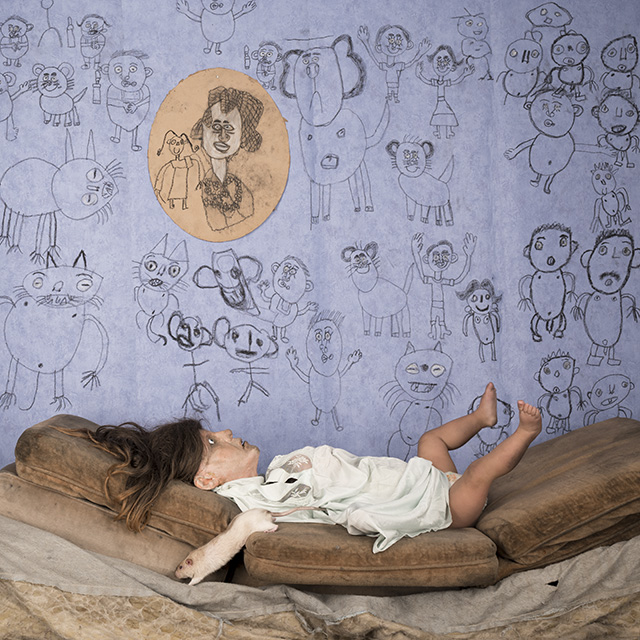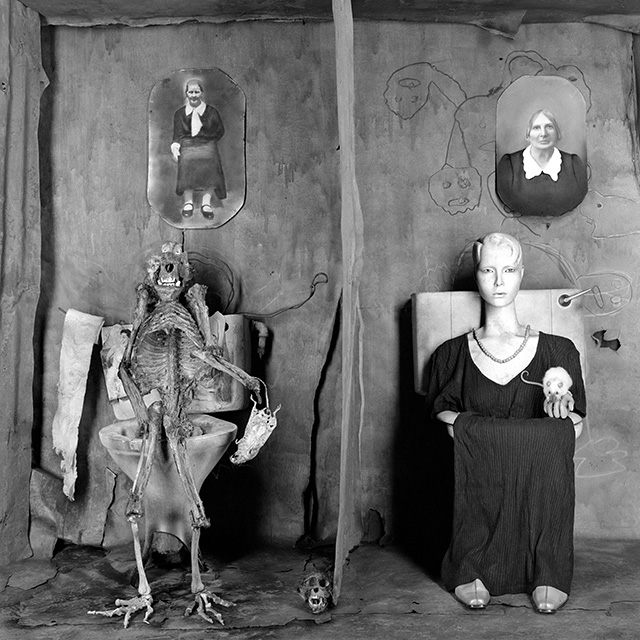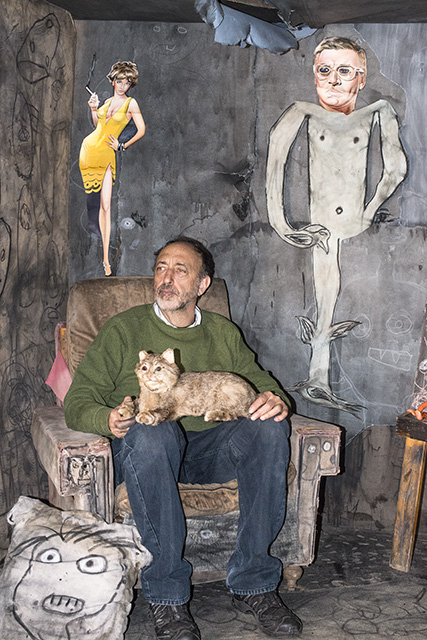 Disconnected, 2017
Disconnected, 2017
Roger Ballen is in Berlin when I meet him, staying in a trendy designer hotel on the banks of the River Spree. You enter past a photo booth into a vast, colourful lobby area staffed by three receptionists behind a huge, purple oyster-shaped desk. Red jellyfish-like chandeliers dangle from above, and dotted here and there are an array of garish and highly uncomfortable seats. It is a surreal and yet oddly appropriate setting to meet with Ballen, who is already in the midst of back-to-back meetings. Tall and looming, with a demeanour that is mild-mannered,
gentle and courteous to others, Ballen is nonetheless to-the-point about his work, possessing an uncanny enthusiasm and total self-conviction. He has just finished teaching a workshop in Berlin, and will soon fly back home to South Africa. Ballen will be back in Europe for the opening of an exhibition at the Halle Saint Pierre in Paris (which opens 07 September and runs until the end of July next year), accompanied by a major new book published by Thames & Hudson, both titled The World According to Roger Ballen. Halle Saint Pierre is a museum devoted to outsider
art, and the exhibition, Ballen explains, “will be multidimensional, containing eight installations, with a silicon, life-size alter ego of me, otherwise known as Roger 2, who will be spinning around the space taking photographs”. He describes the space as being shaped like a pie, and in each piece will be a separate installation devoted to previous projects such as Theatre of the Absurd, made in 2016, referencing the plays of existentialist writers such as Albert Camus, who emphasized the irrational and illogical, a concurrent theme throughout Ballen’s oeuvre. In another room will be videos, and in another, enclosed in cabinets, Ballen’s private collection of art brut, ranging from African sculpture to drawings by children and psychiatric patients. On another floor in the exhibition will be a division of themes such as ‘Wires’, ‘Real/Unreal’ and ‘Apparitions’ – subjects that have preoccupied Ballen over the years. There are also unseen colour photographs taken by
his long-time artistic director, Marguerite Rossouw: “Documents of me in the sets and installations I have created for my black-and-white photographs,” Ballen explains. “They show me in the process of making the work in these particular situations.”
The World According to Roger Ballen is essentially a compendium of his thinking and processes, revealing his appreciation of and identification with outsider artists. The definition of outsider art – or art brut (as termed by one of Ballen’s most important influences, Jean Dubuffet), or naïve art and any number of overlapping terms – is necessarily loose. But it’s widely assumed as an umbrella term for untrained artists who work outside the mainstream of society and art production, often with little care or idea about the history or meaning of art as it’s more commonly understood. The first chapter of the book is titled Journey, presenting the crux to the reasoning that has laid the foundation of his creative output and distinct visual language. And what emerges is that outsider art is essential to the understanding of Ballen’s work and his trajectory as an artist himself to this day. “There is a colour painting featured in the book that I made in 1973 called The Last Supper. I was 23 years old and obsessively did 30 paintings within four months while I was still living in New York. I never painted in this way again and it was a crucial period for my
creative development. I had never been to art school; in fact before I studied a PhD in geology, I did a degree in psychology, and so I had no background in art. At the time of doing these paintings I did not continue because I could not find a way to integrate painting into my photography.” The Last Supper is a depiction of a man sitting at a table; he is reflected in the plate below him, surrounded by gold cutlery and a gold goblet. His face is somewhat surprised by the grotesque reflection of himself, revealing perhaps what the Swiss psychoanalyst Carl Jung terms ‘the shadow’ – understood to be the unknown dark side of the personality, that part of the human psychology that is instinctive and irrational, and, as Ballen’s mirrored portrait represents, is prone to psychological projection in which our perceived personal inferiority is recognised as being morally deficient. This self-portrait is unable to digest this non-idealised version of himself, typifying an
extreme mental state of being. The World According to Roger Ballen is “a multidimensional world that is the product of my mental transformation, a world transformed by my mind,” he says. “It is a world that reveals itself through itself. The mind is complex and multidimensional, unfathomable, with an independence from the conscious mind. It is also a world that cracks through people’s own repressive nature in an archetypal way, and so people will sense the understanding of it and relate to it, even if they are unable to explain it to themselves in a verbal way. It has become
evident that my photographs contain archetypal symbols that elicit a common response wherever they are seen.” This ‘multidimension’ is most immediately visible in his combining the tools of photography, film and drawings, creating a mise-en-scène of grotesquely interior environments.
 Inevitable, 2013
Inevitable, 2013
What is real and not real is thrown into chaos as an array of ephemeral objects – paintings, sculptures, dolls, masks, toys, prosthetics, mostly discovered in flea markets around the world – collide with animals, rabbits, rats and birds. People are willing performative collaborators,
encouraged to draw from somewhere deep inside, uninhibited by the confines of the established art world. The viewer is invited to experience odd juxtapositions that transgress the familiar into
uncomfortable and uncertain visual territory. In his introduction to the Journey chapter, Colin Rhodes, author of the book, Outsider Art, Spontaneous Alternatives, says the term ‘carnivalesque’ is a useful way of understanding the work. “Ballen’s interest and empathy with marginalised people, other psychologies and the deeper, more unruly states of being and mind, suggest affinities with the ideas and activities that lie at the heart of carnival as it arose in medieval Christian Europe, and which has echoes in the fairgrounds and carnivals of more recent centuries.” This draws a line and connects back to Ballen’s early documentary photography entering into the remote small towns and homes of poor white South Africans living on the fringes of society, as seen in his 1994 photobook, Platteland. Ballen has been working with ‘outsiders’ for nearly 40 years, those people who have been featured in a series of equally controversial books, including Outland, Shadow Chamber, Boarding House and Asylum of the Birds. “Even though many of the individuals I have encountered have no job, family or possessions, they have accepted their situation without bitterness or resentment,” claims Ballen. “And over time, I have interacted with many art brut artists whose creative skills are superb. Some of their artworks, whether they be drawings on walls, paper or random objects, have found their way into my imagery. Often, a photograph will start with one or more of these drawings, or they might be inserted as the photograph evolves. These works of art have provided my imagery with additional layers; but to those individuals who created them, whose existence straddles the shadow of time, it is hard to fathom what their impact is.”
He is keen to point out that The World According to Roger Ballen is not a retrospective (for that, see Ballenesque, published last year), but rather an elaborate summation that contextualises his work within the field of outside art. However, the book and exhibition do honestly reveal his thinking and his working process, and they go some way to demystifying his methodology, shining light into his dark world. Much of contemporary art photography, when dealing with issues of identity, uses identity politics as the polemical rhetoric to state that we are products of society and culture, that we are socially constructed. Ballen emphasises the opposite. He draws on the biological and psychological aspects of the human condition, articulating the idea that we are not so much a social construction as a product of thousands of years of human development, and that we still carry with us a deeply primal core. Jung describes the shadow within us as “a moral
problem that challenges the whole ego-personality, for no one can become conscious of the shadow without considerable moral effort. To become conscious of it involves recognizing the dark aspects of the personality as present and real. This act is the essential condition for any kind of self-knowledge”. In other words, we start with ourselves, before preaching to others. It’s why, when Ballen first began giving interviews about his work after the publication of his breakthrough book, Outland, in 2001, he described the pictures as “self-portraits”, explaining that, “The subject is my state of mind”. Ballen seems to have made Jung’s quest for self-knowledge his own grail. And he has integrated himself into his work to the extent that it’s difficult to distinguish the two. He is now able to claim, with some believability, his Ballen-esque status. It is time to leave the designer hotel on the shores of the Spree. Ballen sits on the seat of the photo booth, posing for my portrait. He
appears strangely at odds in this context and yet, in Ballen’s theatrical world, it seems uncannily familiar.

Roger in the Family Room, 2013 Photograph by Marguerite Rossouw
Further viewing
The World According to Roger Ballen
is published by Thames & Hudson, priced £35.
The exhibition runs at Halle Saint Pierre in Paris
from 07 September to 31 July.
thamesandhudson.com
hallesaintpierre.org

Comments are closed.